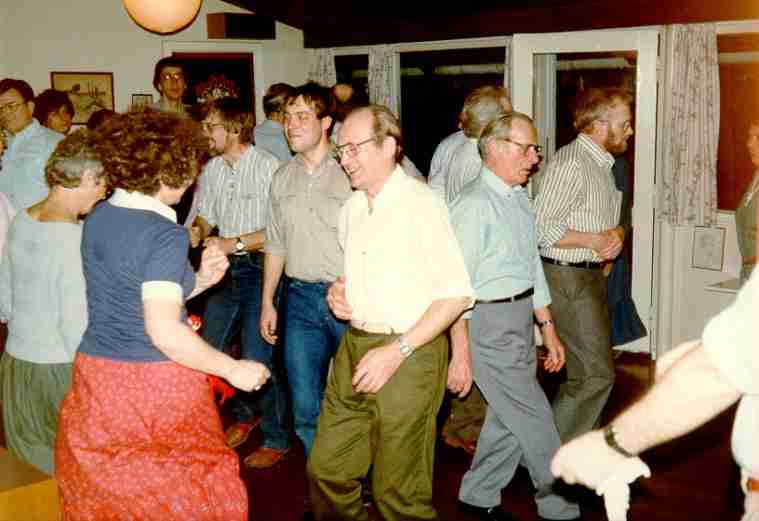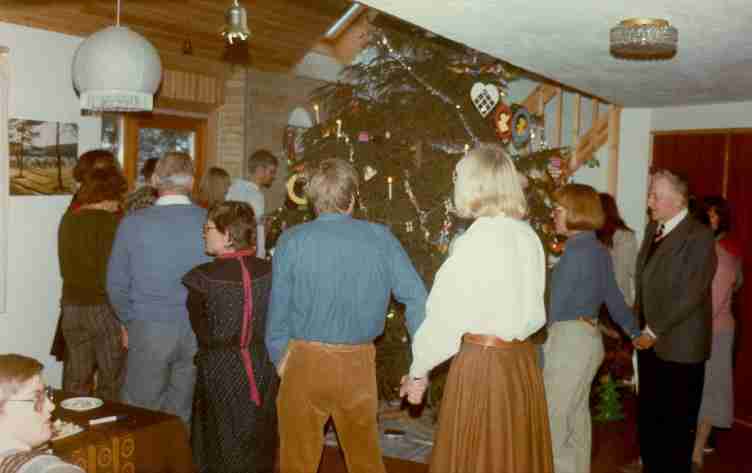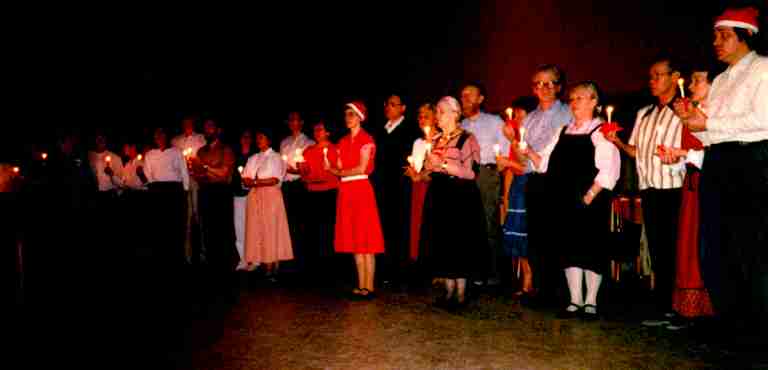
Spillemand spil lystigt op (Yule Tree Dance) |
| Niels Mejlhede Jensen, Bøgeløvsvej 4, 2830 Virum, Denmark. e-mail (web master) |
CONTENTS: (remember: you can use Ctrl Home in usual browsers to get to the top of this page, to the links here)

Photo 1 of Christmas week: big circle around the Christmas tree
on 5' Christmas Day in our home for folk dance Yule feast.
The following year and for some years we made it a tradition with open
Yule house. Then even 3 big crowded circles could not hold everybody (50
to 100 folk dancers would pay us a Yule visit). It is reasonable easy to
have that many folk dancers as guests as they all help with food and sit
where they can or prefer to stand. Musicians are always there to play for
joy, and as soon as they play there is dancing for as many as there is
space for, while others chat and get to know each other for more than just
dancing. The social life and concern that has evolved from this folk dancing
group is amazing.

Photo 2 of the Christmas week: Yule dance in our living room
with limited space.

Photo 3 of the Christmas week: Yule dance in Fiddlers' Dance last Tuesday before Christmas. We stand in a big circle holding Christmas candle lights and singing: Holy Night and other traditional Danish Christmas songs. This gives a nice mood.
Dance of the Christmas week, 1998:
The melody can be heard in midi on computer piano in my tempo (if you
have a sound card). (The melody will loop here until you stop it. In the
table below it will play once). (I have not played the tunes here with
the "drive" I want for dance music).
| 1 | melody | the traditional good dancing melody, polished through generations of use on the fiddle | |
| . | chord
text |
Midi metronome = 110 | simple (folk music) chords, natural for playing the accordion;
these chords are used to make the other parts or voices in triad harmony; there should be no tension from dissonance anywhere including in octave |
| 2 | A | (Above), parallel part nearest above in third or little more above | |
| 3 | B | (Below), parallel part nearest below in third or little more below | |
| 4 | ns | simple n part; often with the tonic feeling and often with the basic dance rhythm ("motor part") | |
| 5 | C1 | C parts are made from A and B parts, and so they are two parts to the melody | |
| 6 | C2 | C2 is less simple than C1 | |
| 7 | C3 | . | |
| 8 | mod =
contra part |
voice up and down (mostly) contra to the melody; it is also made from A and B | |
| 9 | n1 | n is a less constricted part, and tones from the melody are freely included | |
| 10 | n2 | . | |
| 11 | C1 | octave up | |
| 12 | blank | . | blank staff for making your own part according to the principles here |
If you play this tune for a continues polka, play it as noted in the
music note sheet, with a normal quick transition from the last bar to the
start bar.
But if you play it for the dance I have described
here on this site, the last note, a crotchet (1/4 note), should have
a pause to double its value, like when you are playing the melody for singing,
or the last bar is 3/4 instead of 2/4 ending with a minim (1/2 note). I
have played the above looping melody in midi with this minim end note between
the first and second play. When it loops after second play etc. I do not
control the rest needed for the melody to start again, so maybe disregard
that.
Although the song text may indicate this to be a melody for fiddlers
it is not so easy a tune to remember by heart to play naturally well for
everybody. But the song is very much Danish Christmas.
Use also octave, up and down in the parts to vary the music.
Where wanted, notes can be changed according to the principles (use
a colour pencil), e.g. to improve the B part with some notes from
A.
The music is aimed at dancing, so part of the orchestra can be the
underlying "motor" when another instrument group is playing its "solo"
part (improvisation) as one of the many repetitions.
The double bass may play its usual notes, because of its low pitch.
It is better to choose a more simple part and play it well.
Accordion: beats per bar: 2+2
(Help coming back from that note
sheet: CLICK the note sheet to come back to this page, or just close
the note window.
Remember: the note sheet opens in a new separate window, and that may
cover the whole screen. The back button in the tools bar does probably
not work because the window is new, with no history. All you see on the
page are notes because I have placed no link back here for not disturbing
easy submitting to the printer. Close the note window with a click at the
top or with Alt F4, or minimize or reduce the window, or ..., and you are
back to the main page that was there behind all the time).
The melody and song here is very traditional Danish for our Christmas. But it is not quite from before 1860, and can therefore not be considered a genuine Danish folk dance melody according to those rules. This does not bother me though, as long as the dance and tune enjoy all right. Even though the song text encourages the fiddler to play, the melody proves not to be among the most easy to play by heart.
This here was the fist dance I made for the internet web, to make a start in 1998. I then wrote it in the Danish language. But a book told me that the language should be English. So I have revised it to this, here in April 1999, to add it to my collection before I have to stop, because my web site MB is getting filled up.